ABSTRACT
A quantitative study was conducted in the Eastern zone of Tanzania, from May to September 2012 to assess farmers’ knowledge, altitude and practice on the use of locally available plant materials for controlling rodent damage in maize fields and stores. Three villages in three districts were purposively selected with a total of 270 farmers randomly selected for the interview. A semi structured questionnaire was used to assess maize production constraints. Rodent pests were ranked higher (56%) than other pests with their crop losses estimated to be 64 and 36% in fields and stores, respectively. Use of rodenticides for rodent control was reported as the common single method. However, 85% of farmers use rodenticides with inadequate knowledge on application and their effects on the environment and health. It was further revealed that only 15% of the respondents reported to have attained training on how to apply rodenticides. With regard to the use of locally available plants, 4% of respondents reported to use them for rodent control, while 96% were not aware of any plant that was effective against rodents. However, most (97%) respondents expressed their willingness to use plant materials if provided with evidence that they are effective. Therefore, evaluation of plant materials and consequent development of plant products which can be safely used by poor resource farmers and subsequently reduce health and environmental risks associate with chemical rodenticides was recommended.
Key words: Rodents, plant materials, maize, Tanzania.
Maize (Zea mays L.) is cultivated in the tropical, subtropical and temperate regions of the world and is the most important staple food reported to be the 5th agricultural commodity in The United Republic of Tanzania (Anna, 2014). According to FAOSTAT (2013), maize represented five percent of total agricultural imports in The United Republic of Tanzania during the period 2005 to 2010. In Tanzania, maize is grown all over the country in more than 20 regions where approximately 65 of maize grown by poor smallholder farmers (Barreiro-Hurle, 2012). It has been also reported that maize is predominantly used for multiple purposes largely for human consumption and animal feeds (William et al., 2012). It provide main energy source in the diet accounting for 25 percent of total caloric intake (FAOSTAT, 2013). According to Jeffrey and Maria (2014), 60 to 70% of maize production Worldwide is used domestically as livestock feed and the remaining 30 to 40% used for production of items for human consumption. It is reported that maize for human food involves boiling or roasting the green fresh maize on its cob or milling into flour for preparation of stiff porridge (‘‘ugali” in Swahili). Additionally in some areas of Tanzania, example in Iringa region however, green maize stems are occasionally used as sugar cane whereby residents chew and suck the sugary juice in the stems (Kilonzo, pers. Observation). In some areas maize cobs has many agricultural and industrial applications including using them as fodder for ruminants despite their low nutritive value (Jansen, 2012). They (cobs) are also used as fuel for cooking or heating purposes, especially in traditional households and small scale farms. In other parts of the world, e.g German, strong incentives were set to produce biogas from dedicated energy crops of which the prominent plant was maize (Herrmann, 2013; Britz and Delzeit, 2013). In Tanzania, maize is the most staple food for the majority of Tanzanians grown for both subsistence and as a cash crop (Trevor and Lewis, 2015). It has been reported that 80% of maize production have been under small-scale farmers (Trevor and Lewis, 2015). However, according to Trevor and Lewis (2015), the maize yields in Tanzania is hampered by several problems including uncertain land tenure, little access to affordable finance, poor rural infrastructure, periodic bans on cereal exports, corruption, local taxes on farm production, the limited availability of improved seed, weak business skills and inadequate institutional and technical capacity.
Additionally, like other crops soil infertility, drought, weed infestation, crop diseases and pest attack has been reported as a factor for reduced maize crop yield (Min et al., 2013). Vertebrate pests, especially rodents are most important contributing to maize crop damage during seedling stage and in stores resulting to a serious threat for reduction of income and widespread of food shortage (Mohammed, 2013). However, in their endeavor to reduce the rodent infestations, most small-scale farmers in many places of Tanzania use acute rodenticides so that dead bodies of the pests are seen shortly after application (Mulungu et al., 2015). However, according to the authors the use of synthetic rodenticides may facilitate development of bait shyness (toxiphobia) among the target species. This will then require surplus baiting to ensure that most of the rodents have access to the bait and can consume adequate dose of the same. Additionally, rodenticides are hazardous to environment or cause risks to non-targeted organisms including humans and livestock. Therefore, appropriate rodent control programs relying on ecologically based approaches which require minimal or none chemical dependence should be thought. It is reported that the awareness and use of pesticidal plants in developing countries is growing over time following the scientific proof of damages caused by synthetic pesticides (Mkindi et al., 2015). According to the authors, pesticidal plants are preferred because of their non-cytotoxicity, easy of biodegradability and simulator nature of host metabolism and hence more environmental friendly compared with synthetic compounds. In recent time across Africa, there is a massive availability of plants which have been identified for their pesticidal effects particularly for insect pest control with little effort in rodent management. This study therefore, aimed to investigate and provide information on the knowledge of Tanzanian small scale farmers on the use of locally available pesticidal plants for rodent control.
Study areas
The study was carried out in Handeni, Mvomero and Kilosa districts in the Eastern zone of Tanzania between May and September 2012. In these districts, agriculture is the major economic activity which provides the main source of income for the entire population where by maize is the main food and cash crop for the majority of farmers. Three villages in each district were purposively selected basing on the history of rodent damage in maize crop. Handeni district is located at 5"30' 00" S and 38"0'00" E and an elevation of 581 meters above sea level. It is one of eight districts of Tanga region bordered to the west by the Kilindi district, to the north by Korogwe and Muheza districts, East by Pangani district and to the South by Pwani Region. There are two rain seasons, i.e short rains which fall from October to December, and the long rains from mid-March to June. The dry season is between July and September. The mean annual precipitation is 800 to 1500 mm in the lower altitude areas and rain shadowed areas in the lee ward side of the mountains in the Northern and north-western areas may have about 400 mm only and a single rainfall season. This amount of rainfall supports the growth of crops such as cassava, maize, beans, ground nuts, citrus fruits, millets and sorghum. Maize is a staple crop grown largely by small-scale farmers and stored in roof and sacks after harvest for future use (Shabani et al., 2015). With regard to Mvomero district, it is located at 6°15' S and 38°40' E and an elevation of 506 meter above sea level. It is one of the six districts of the Morogoro region of Tanzania bordered to the north by Tanga region, to the northeast by Pwani region, to the east and southeast by Morogoro rural and Morogoro urban, respectively, and to the west by Kilosa district. The approximately mean annual rainfall in the area is about 800 to 1000 mm (Mkonda, 2014). Mvomero district has various type of soil ranging from sandy clay loams, sandy clays and sandy loams. The major food crops grown in Mvomero districts in small-scale farming are maize, sorghum, cassava, cowpeas, pigeon peas, lablab, sweet potatoes and rice. Crop storage practices in the area vary from crop type where the maize and rice crops stored using sacks. Similarly, Kilosa (6°55' S and 36°59' E at an elevation of 604 meter above sea level) is one of the six districts of the Morogoro region of Tanzania bordered to the North by Manyara region, to the Northeast by Tanga Region, to the East by Mvomero district, to the Southeast by Morogoro Rural, to the South by Kilombero district, to the Southwest by Iringa Region and West by Dodoma Region.
Kilosa District comprises mostly flat lowland that covers the whole of the eastern part called Mkata Plains. Kilosa district soil differ very little between villages from sandy to sandy loam. The district experiences an average of eight months of rainfall (October to May), with the highest levels between February and March. The rainfall distribution is bimodal in good years, with short rains (October to January), followed by long rains (mid-February to May). Mean annual rainfall ranges between 1,000 and 1,400 mm in the southern flood plain, while further north (Gairo Division) has an annual rainfall ranging from 800 to 1,100 mm. The mean annual temperature in Kilosa is about 25°C and is famous for cultivating a variety of crops due to its good environmental conditions. However, maize is a dominant crop grown by almost every household. Other crops include rice, millet, bananas, tomatoes, cassava, sunflower, pigeon peas, sweet potatoes, beans and a variety of vegetables. A few households also cultivated coconuts and cashew nuts. Most crops are used for both own consumption and trade (Wassena et al., 2013). All of the studied districts have a bimodal rainfall pattern with maize crop produced twice a year under short and long rains. The first cropping season (short rain) from late November to February and the second (long rain) March to June.
Sampling procedure
In this study, multistage sampling technique was employed and the sampling frame was the district, village, and finally a household. Purposive sampling was used to select the districts and villages with rodent infestation. In each of three selected districts three villages were selected for survey, making a total of 9 villages. In each selected village, the list of farming households growing maize was used as a sampling frame from which respondents were randomly selected. Thirty farmers were sampled in each village giving a total sample size of 270 farmers (90 in each district).
Data collection
Information regarding farmers’ knowledge, attitude and perception on the use of botanicals for controlling rodent pests was collected using semi-structured questionnaire containing both closed and open ended questions. The questionnaires were designed to seek information on socio-economic characteristics (age, education, farmer’s experience on farming, major source of income, the farm size at household level, rodent control measures used, knowledge, altitude and perception on the use of pesticidal plants for rodent control. A question on the ranking of maize production constraints was also addressed.
Statistical analysis
The questionnaires were checked and edited for completeness and internal consistency. They were then sorted, numbered and coded before entry into access software. Quantitative data processing involved categorization, reorganization, editing, coding and entered in a computer using Statistical Package for Social Sciences (SPSS) program volume 16. A substantial part of the analysis in this study was based on descriptive statistics analysis using SPSS computer software based on t-test, frequency analysis and percentages. Data were presented in form of texts, histograms and tables to illustrate findings.
Sex ratios and socio-economic characteristics of respondents
Out of the 270 respondents interviewed in the three districts, 62.7% were males and 37.3% females. As regard to age structure, most respondents (96.3%) were above 25 years old while only 3.7% were below this age and majority of respondents (76.3%) were single (Table 1). In all districts most of the respondents (36, 32 and 32% in Handeni, Mvomero and Kilosa, respectively) had primary school education. The proportion of respondents with secondary school education was higher (75%) in Mvomero than in Handeni and Kilosa (17%) and 8% respectively). When asked on the sources of income, 58% of respondents in all three districts mentioned agriculture as their major source, while 42% mentioned non-agricultural activities (small business and salaries) as their source of income (Table 1). With regard to experience in farming, most of the respondents (86.3%) reported that they have been in farming for more than 5 years while some farmers (13.7%) said that they had farming experience for less than 5 years (Table 1). As regard to cultivated farm size, it was shown that majority 24, 13 and 42% of the farmers in Kilosa, Mvomero and Handeni district, respectively cultivate 3 and above acres. The response outnumbered those farmers 8, 10 and 3% from Kilosa, Mvomero and Handeni district, respectively who cultivate smaller areas bellow 3 acres (Figure 1).
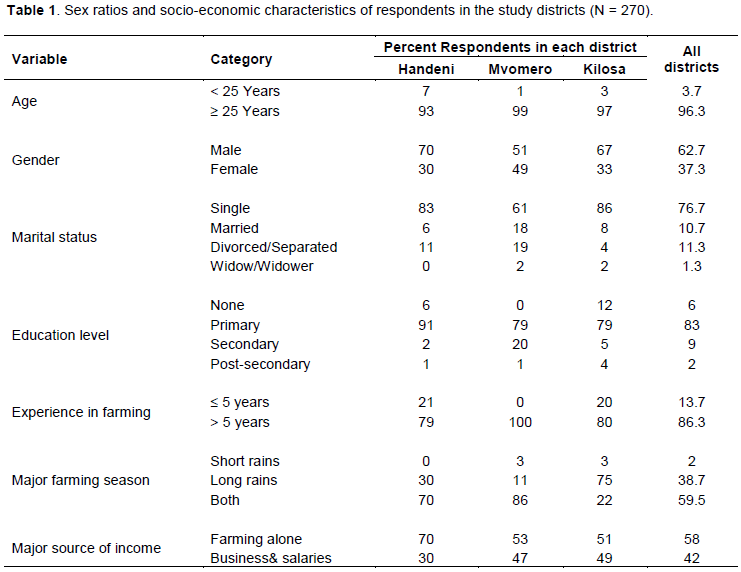
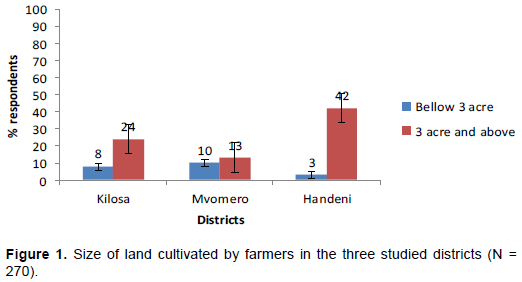
Maize production constraints
Results show that in all three districts, rodents cause substantial damage to maize both in the field and home stores and that they, together with storage insects and lack of farm inputs, comprise the major constrains to production of the crop in the area (Table 2). When asked whether the farmer could differentiate various species of rodents, 80% of them (farmers) showed ability to differentiate the animal by color and 20% differentiated them (rodent) by morphological, body size, mouth structure and residence that is, (house or field rodents). When respondents were asked about the development stage at which maize was most damaged by rodent pests, their responses indicated that rodents mostly damage maize soon after sowing (55%) followed by damage at germination stages (35%) (Table 3). However, some few respondents 6 and 4% claimed that their crops were being damaged during flowering and at maturity stage, respectively (Table 3). Most of farmers (100%) reported that the rodent damage after sowing and at seed germination forces them to re-sow the seeds a situation that doubles the production costs.
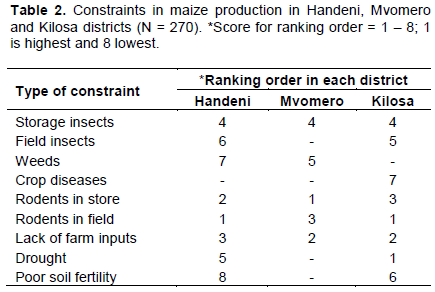

Mvomero and Handeni, respectively had used poison to protect their crops from being damaged by pests. Likewise, 43% of respondents in the three districts claimed to have applied rodenticides both in field and stores (Figure 2). It was further revealed that farmers applying rodenticides separately in fields and stores comprised 37 and 20%, respectively. Investigation on frequency of rodenticide application per farming season showed that 30, 46 and 24% of farmers apply once, twice and thrice, respectively. Although farmers in the study area applied rodenticides as one of the rodent control measures, most of them (85%) claimed that they had never attended anytraining on handling and application of such chemical (Figure 3) and that they depend on their experience in undertaking such activity. Furthermore, 63% of the farmers reported that they provide verbal information to their neighbours prior to application so as to caution the latter on the activity. With regard to the source and availability of rodenticides, most farmers (51%) responded that they obtain the chemical from local markets and that they are available at such places.
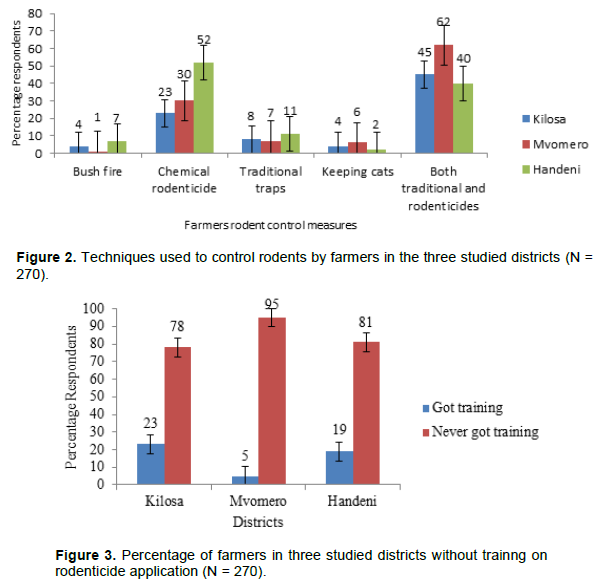
Effectiveness of rodenticides
When asked about effectiveness of rodenticides they use, farmers had different perceptions ranging from excellent (36%), very good (24%), good (21%) to fair (18%). Only few farmers (1%) replied that the rodenticides used do not work at all (Figure 4).
Farmers’ awareness on the use of pesticidal plants for rodent control
When asked if they had ever used pesticidal plants for controlling rodent, majority (96%) of farmers replied that they had never done so. However, they reported that most known pesticidal plants were used for controlling insect pests. Such plants mentioned in local languages and later on translated to English and botanical names included Aloe (Aloe vera), Neem (Azadirachta indica), Pepper (Capsicum spp), Mimosa (Mimosa pudica) and Tobacco (Tabacum spp). In response to inquiry as to whether farmers had any information regarding plants which can be used for controlling rodents, most (96%) respondents contended that they were not aware and, the remaining (4%) of the respondents reported to have used some pesticidal plants including Tabaccum spp, Mimosa pudica and Strychnos henningsii for rodent control. Despite the lack of awareness on the use of pesticidal plants for controlling rodents, most (97%) farmers expressed their willingness to use such botanicals if and when informed about such plants and their capability of controlling rodents (Figure 5).
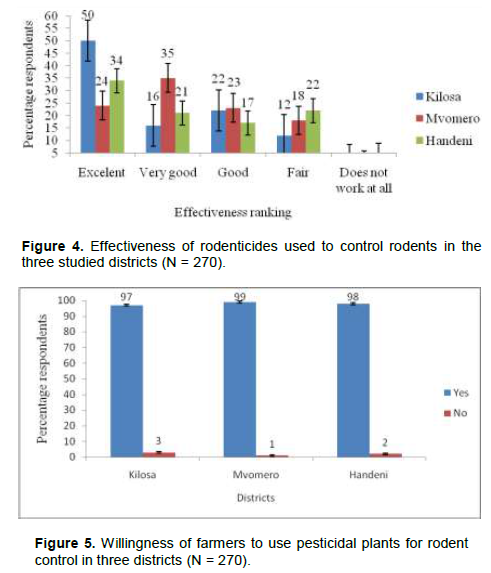
Constraints to maize production
The current report by farmers that rodent pests, storage insects and lack of farm inputs are the major factors hindering maize crop production in the three districts are partly consistent with observations by Min et al., (2013) that maize yields are hampered by problems such as soil infertility, drought, weed infestation, crop diseases and pest attack. Similarly, a survey by Mulungu et al. (2015) reported that in Mvomero district of Tanzania maize and rice which caused a losses ranging from an average of 20 to 80%. Furthermore, the report by the majority of farmers in the current study that maize is most damaged by rodents soon after sowing are similar to observation in Ethiopia reported by Mohammed (2013) who reported that rodent cause a great damage by eating the seed before and after its germination stage with 1 to 2 leaves which then forces farmers to replant the field with other seed. In general, rodent associated problems together with other constraints including storage insects, lack of farm inputs, drought, crop diseases and poor soil fertility have been major obstacles for maize productivity in many areas of Tanzania.
Rodent control methods used by farmers
The current findings that rodent control measures applied by farmers in the study areas and their ranking vary from one location to another and the use of rodenticides was the commonest method reported by most (84%) farmers followed by the use of other control measures reported by 15% farmers indicated that rodenticides is more used by Tanzanian farmers as crop protectants against rodent pests. However, it was observed that most of the farmers were not familiar with the name of the rodenticides they use. The study revealed that small number of famers mentioned Zinc phosphide while the majority of them described the chemicals on the basis of the latter’s colour and other physical features.
Based on farmer’s descriptions, the rodenticides were identified as Zinc phosphide (Zn3P2) and Temic, and were being used by 53 and 21% farmers, respectively. The observation that majority (85%) of farmers did not have any training on the use and handling of rodenticides was interpreted to suggest improper application of rodenticides by farmer. Indeed, 63% of farmers reported to use zinc phosphide in their houses an undertaking which is highly dangerous to human and animal health. Zinc phosphide is very poisonous and should be used under control of the government especially in rodent outbreaks.
Likewise in Tanzania, the chemical is only allowed to be used under strict supervision by well trained personnel and its use in plague endemic area is strictly forbidden (Tesha, 2016, Personal communication). It has been reported that zinc phosphide and temic reportedly pose hazards to wildlife species up to 4th and 7th consumer level, respectively, (Ngowo, 2012, Personal communication). On the basis of the rodenticide – associated risks therefore, search for and use of alternative rodent control measures that have no or limited risk to farmers is advised. With regard to rodenticides (Ratox, bait powder made in Kenya) costs in Tanzania is about one thousand Tanzania shillings for a packet of one gram (Personal observation). This kind of rodenticides is sold at vendors of which are uncontrolled markets. It is reported that the amount of 27 to 40 mg zinc phosphide is needed to kill a rat at acute oral LD50 of mg/kg. However, base on lack of training to farmers it happen that more rodenticides improperly applied to fields and causing possible effect to nontargeted organisms. Therefore, there is a need to reduce this contamination by finding alternative methods of rodent control.
Farmer’s awareness on the use of pesticidal plants for rodent control
Pesticidal plants have been used by African farmers for generations and are of importance to poor, small-scale farmers for effective, low-cost pest control. However, in this study the use of pesticidal plants constituted a smaller portion of the rodent control options in all the study districts. Of all respondents, only 4% reported to have used pesticidal plants for rodent control compared to 96% who used acute poisons. This study shows that the use of pesticidal plants by Tanzanian farmers is concentrated largely on insect pest control.
However, although farmers in the study areas knew different kinds of plants with insecticidal effects, most of them were not aware of any plant with rodenticidal effect. Therefore, there is a great need to search for pesticide of rodenticidal effects to be used in reducing the crop damage caused by rodent pests.
On the basis of the current studies together with earlier observation reported elsewhere, it can be justifiably concluded that rodents are the most important constraints to maize production in Morogoro and Tanga regions and that they occur almost every month. It is also conclusive from these findings that lack of farm inputs is the next important constraint causing significant reduction in maize crop production.
Furthermore, it can be concluded that most farmers in Handeni, Mvomero and Kilosa districts use rodenticides for controlling rodent pests despite lack of training on the proper application of such chemicals. Additionally, it is conclusive from the study that most farmers are unaware of potential use of botanicals for controlling rodents but are willing to adopt the method if and when informed about appropriately effective pesticidal plants. A need to evaluate and develop useful pesticidal plants product as a rodent control strategy that can be adopted by farmers in rural areas to reduce rodent damage to sown maize seeds and other stages in maize crop production, is strongly recommended.
The authors have not declared any conflict of interests.
The authors are very grateful to Commission for Science and Technology (COSTECH) Tanzania for the financial support that enabled us to conduct this work. We also thank all Village Extension Officers in Handeni, Mvomero and Kilosa districts for the assistance they provided during the course of data collection. Furthermore, we wish to express our gratitude to farmers who participated fully in this study. Last but not the least, we wish to thank the Management of each author’s institution for authorizing him/her to participate in this study.
REFERENCES
|
Anna GM (2014). Access to and adoption of improved seedsby smallholder farmers in Tanzania, A dissertation submitted in partial fulfillment of the requirement for the degree of masters of arts in rural
|
|
|
|
Barreiro-Hurle J (2012). Analysis of incentives and disincentives for maize in the United Republic of Tanzania. Technical notes series, MAFAP, FAO, Rome 61 p.
|
|
|
|
|
Britz W, Delzeit R (2013). The impact of German biogas production on European and global agricultural markets, land use and the environment. Energy Policy 62:1268-1275.
Crossref
|
|
|
|
|
FAOSTAT (2013). World Food and Agriculture, Agricultural Production Statistics 2012. FAO Statistics Division, Rome. 299 p.
|
|
|
|
|
Herrmann A (2013). Biogas production from maize: Current state, challenges and prospects. 2. Agronomic and environmental aspects. Bioenergy Resour. 6:372-387.
Crossref
|
|
|
|
|
Jansen C (2012). Breeding for cob traits in maize, A dissertation submitted to the graduate faculty in partial fulfillment of the requirements for the degree of Doctor of Philosophy, Iowa State University 136 p.
|
|
|
|
|
Jeffrey AG, Maria NG (2014). Processing maize flour and corn meal food products, Annals of the New York Academy of Science, Issue: Technical Considerations for Maize Flour and Corn Meal Fortification in Public Health 10 p.
|
|
|
|
|
Min W, Qingsong Z, Qirong S, Shiwei G (2013). The Critical Role of Potassium in Plant Stress Response, Int. J. Mol. Sci. 14:7370-7390.
Crossref
|
|
|
|
|
Mkindi AG, Mtei KM, Njau KN, Ndakidemi PA (2015). The Potential of Using Indigenous Pesticidal Plants for Insect Pest Control to Small Scale Farmers in Africa. Am. J. Plant Sci. 6:3164-3174.
Crossref
|
|
|
|
|
Mkonda M (2014). Rainfall variability and its association to the trends of crop production in Mvomero District, Tanzania, European Sci. J. 10:1857-7881.
|
|
|
|
|
Mohammed K (2013). Pest Rodent Species Composition, Level of Damage and Mechanism of control in Eastern Ethiopia, Int. J. Innov. Appl. Stud. 4(3):502-511.
|
|
|
|
|
Mulungu LS, Mrosso FP, Katakweba AAS, Mdangi ME, Tesha PPH, Ngowo V, Mchomvu M, Kilonzo BS (2015). Farmer's knowledge, attitude and practice on rodent management in lowland irrigated rice in Central-eastern Tanzania. Int. Res. J. Plant Sci. 6(1):7-14.
|
|
|
|
|
Shabani I, Martin EK, Peter NG, Conrad B, Bovell-Benjamin AC (2015). Maize Storage and Consumption Practices of Farmers in Handeni District, Tanzania: Corollaries for Mycotoxin Contamination. Open J. Prevent. Med. 5:330-339
Crossref
|
|
|
|
|
Trevor RW, Lewis J (2015). The Maize Value Chain in Tanzania. A report from the Southern Highlands Food Systems Programme. 76p.
|
|
|
|
|
Wassena F, Mbeho A, Maass BL, Lukuyu B, Kimambo AE (2013). Enhancing dairy-based livelihoods in India and Tanzania through feed innovation and value chain development approaches: Report of a livestock feed assessment in Kilosa District, Morogoro Region, the United Republic of Tanzania, International Center for Tropical Agriculture (CIAT), Nairobi, Kenya 18 p.
|
|
|
|
|
William G, Andre W, Andre L (2012). Maize Value Chain in the SADC Region, Technical Report Submitted by AECOM International Development to USAID/Southern Africa, February 2012 USAID Contract No. 674-C-00-10-00075-00 58p.
|
|